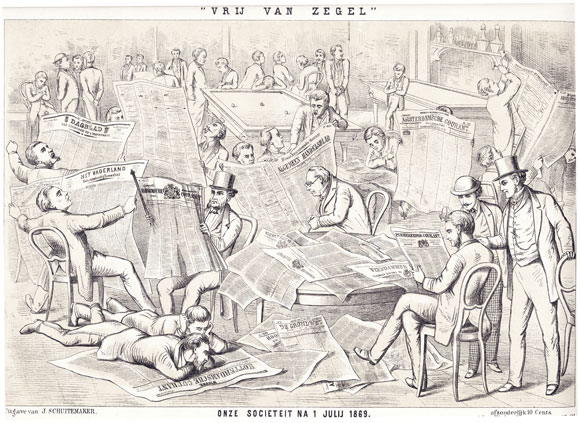1800-1900: Struggling against Censorship

Ingeplakte prent 'Vrij van Zegel', uit de Purmerender Courant na afschaffing van het Dagbladzegel,
1869
.[Pasted-in print 'Vrij van Zegel' [Free of Stamp], from the Purmerender Courant following abolition of the Dagbladzegel, 1869]
Abolition of the Dagbladzegel
The 19th-century Dagbladzegel originated from the time that the Netherlands had been part of the French Empire (1810-1813). The tax on paper format, which is what the Dagbladzegel essentially was, applied to newspapers, journals, posters and suchlike. A stamp on a newspaper from this period indicates that the Dagbladzegel tax has been paid. Besides the Dagbladzegel, newspaper publishers also had to pay stamp duty on advertisements. Taken together, these fiscal measures led to very high prices being charged for newspapers if the publisher was to have any hope of making a profit. One way of evading the Dagbladzegel was with the 'Lilliput press', which comprised mostly opposition periodicals in a very small format that freed them from the Dagbladzegel. The government put an end to this practice in 1845 by imposing a tax on all formats.
From around 1850 onwards the protests against the Dagbladzegel grew ever stronger. These protests, together with focussed lobbying, eventually led to the government abolishing the Dagbladzegel on 1 July 1869. This step was strongly welcomed, and the newspaper could finally develop as a mature medium.
The 19th-century Dagbladzegel originated from the time that the Netherlands had been part of the French Empire (1810-1813). The tax on paper format, which is what the Dagbladzegel essentially was, applied to newspapers, journals, posters and suchlike. A stamp on a newspaper from this period indicates that the Dagbladzegel tax has been paid. Besides the Dagbladzegel, newspaper publishers also had to pay stamp duty on advertisements. Taken together, these fiscal measures led to very high prices being charged for newspapers if the publisher was to have any hope of making a profit. One way of evading the Dagbladzegel was with the 'Lilliput press', which comprised mostly opposition periodicals in a very small format that freed them from the Dagbladzegel. The government put an end to this practice in 1845 by imposing a tax on all formats.
From around 1850 onwards the protests against the Dagbladzegel grew ever stronger. These protests, together with focussed lobbying, eventually led to the government abolishing the Dagbladzegel on 1 July 1869. This step was strongly welcomed, and the newspaper could finally develop as a mature medium.
Call number:
PM 3966


